Hello and welcome back to my blog! Unfortunately, I must start this post by being the bearer of bad news. This will be my last blog in accordance with the DICE module in DCU. I can hear dismay coming from my fans across the globe, and I apologise, but as the old saying goes, all good things must come to an end. As always sit back relax and enjoy this last blog post!

Sunshine Gif
The start of this glorious day was unlike any other. In Ireland, as many of you know it rains, an awful lot. (Met Éireann, n.d.) have stated that on the East Coast of Ireland it rains for approximately 150 days a year, meaning it rains almost every two days. What made this day different was that it was one of the warmest days we’ve had all year, with the sun shining high in the sky. Straight away I had very high hopes for the day.
As always, the conference lasted 4 hours. However, the first two hours were taken up with a presentation of our group assignment which we have been working
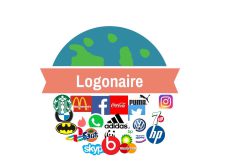
Logonaire Logo
on for the duration of our first year. We had to choose one educational game topic, and create one game element to showcase at the end of the year. Our topic was ‘How to Choose a Logo’, with our team name being Logonaire. Now, I won’t bore you with the details of the game, as I’ll get very side-tracked and forget about the conference itself. If you are interested however, you can check out our website here, or check out our social media accounts below where it also explains what the game was all about. Take a sneak peek below at the picture of myself and my team waiting for the second judge to come around. I was really proud of our team.
Want to hear more about Logonaire? Check out our Website, Facebook, Twitter, Instagram, or YouTube here!
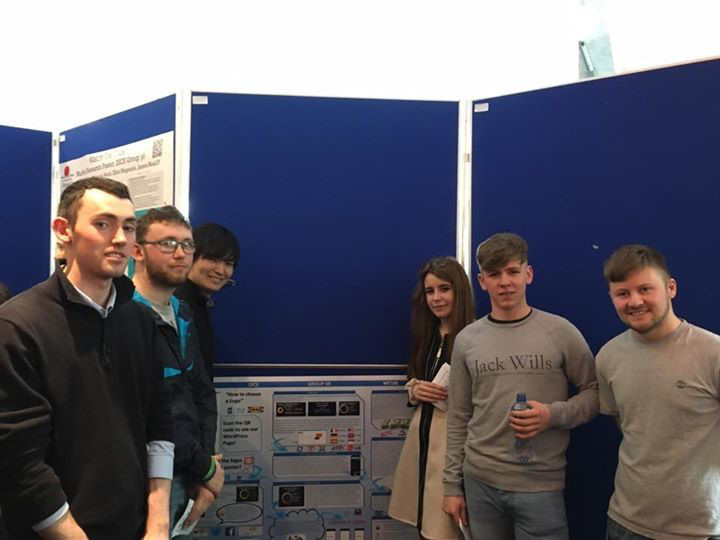
Logonaire at the Get Digital conference
The conference itself was about the digital landscape and how it is rapidly changing. (Jukes, McCain, & Crockett, 2010) spoke about how the youth of today are being greatly impacted by these changes. It’s evident that technology is all around us, to become successful we must understand how to utilize them as we are only at the beginning of this new digital era.
Public Service Announcement
If you read about a company you have an interest in anywhere in this blog post, click on the company logo and it will direct you to their home page so you can find out more!
Dr. Johnny Walker- Jinga Life
Now to start with the actual conference. We were rushed into the Helix hall as we almost ran overtime with our presentations. Nevertheless, the atmosphere was electric as we were greeted by our host for the evening, Joan Mulvihill. This time however, every speaker was from a different country which made it feel like whilst we were listening to the fantastic speakers, we we’re also on a journey around the world. And so, we start our journey here on our green isle of Ireland.
We were quickly transported to the land down under with our first speaker for the night, Dr Johnny Walker. Per (Russell-Smith, et al., 2007) Australia is known for

Australian Flag
many different things like its animal and plant life. Dr. Walker was a hilarious speaker. He spoke about his life in Australia and how the healthcare system today is not about a revolution but rather an evolution. His company  tries to embrace this through technology. (Lenz & Kuhn, 2004) have agreed with Dr. Walker arguing that there needs to be a more continual use of such things like IT to further improve healthcare today. Dr Walker’s vision began in the outback of Australia when he was trying to help the Aboriginal women. He saw that there was a serious lack of medical centres in the outback of Australia and many of these women and their unborn children were dying because of basic medicines they would need to survive. Per (Moodie, 1973) some 43% of North Australia is composed of Aborigines, Dr. Walker knew he needed to help these women. He knew he had to disrupt the healthcare system as we know it. And so Jinga Life was born.
tries to embrace this through technology. (Lenz & Kuhn, 2004) have agreed with Dr. Walker arguing that there needs to be a more continual use of such things like IT to further improve healthcare today. Dr Walker’s vision began in the outback of Australia when he was trying to help the Aboriginal women. He saw that there was a serious lack of medical centres in the outback of Australia and many of these women and their unborn children were dying because of basic medicines they would need to survive. Per (Moodie, 1973) some 43% of North Australia is composed of Aborigines, Dr. Walker knew he needed to help these women. He knew he had to disrupt the healthcare system as we know it. And so Jinga Life was born.
Check out Dr. Walker’s actual presentation here, or check out the video of him speaking in The Helix here!
Johnny Walker Speaking About Jinga Life
Jinga Life is a technology which can be used for the whole family. It aims to facilitate families and individuals to have easy access to their own healthcare records and to let
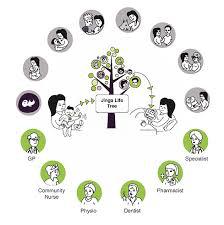
Jinga Life Family Tree
these people be connected to many different health professionals across the globe. They do this by letting these people upload their health records to the secure cloud platform. (Mell & Grance, 2011) described cloud computing as “a model for enabling ubiquitous, convenient, on-demand network access to a shared pool of configurable computing resources (e.g., networks, servers, storage, applications, and services) that can be rapidly provisioned and released with minimal management effort or service provider interaction”. If these people have a problem they can upload the problem to the cloud and within a matter of time they will receive a complete medical diagnostic from a healthcare professional located somewhere in the world. (Doukas, Pliakas, & Maglogiannis, 2010) spoke about how these cloud healthcare systems are now becoming more prevalent today. As Dr. Walker said it’s not a revolutionary healthcare breakthrough, but rather a combination of such technologies to ensure people have a more fulfilled life.
Dr. Walker gave us the staggering estimate that around 30% of new mothers forget important baby healthcare files when visiting doctors for check-ups. He believes he can reduce this percentage by letting mothers have the ability to upload this important information to a secure platform.
Although I do believe that Dr. Walker’s vision and ideas are fantastic and inspiring. I reckon that it will be a long while before we see any major changes being made here in Ireland in relation to the movement of healthcare files from being handwritten and stored in hard-copies to it all being stored on some online cloud platform. Furthermore, as we learnt in one of our lectures with (Lyons, 2017) there can be issues regarding privacy online so in order for this fantastic idea to work, I think there needs to be a lot more time put into computer security.
Want to hear more from Dr. Walker? Check out his LinkedIn or Twitter here!
David Erixon- Ulster Bank
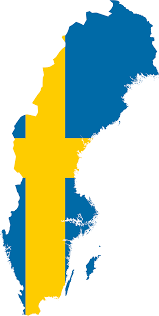
Swedish Flag
Next stop Sweden! A country renowned for its’ numerous inland lakes and thousands of coastal islands which causes wetlands across the country (Olsson, Folke, & Hahn, 2004). David Erixon is the Head of digital and customer Innovation at  . He decided to make the transition from the health system to that of banking quite swift when he gave us a nice little note to ponder upon. If blood is the currency of health, then money is the currency of wealth. And it’s true in today’s society I believe everyone is obsessed with two things, trying to better themselves and making sure they have the ability to do so, i.e. obtaining satisfactory levels of wealth and health. Per (Easterlin, 1995) those who have more money are generally happier in life so it’s no wonder that people today try to increase their wealth.
. He decided to make the transition from the health system to that of banking quite swift when he gave us a nice little note to ponder upon. If blood is the currency of health, then money is the currency of wealth. And it’s true in today’s society I believe everyone is obsessed with two things, trying to better themselves and making sure they have the ability to do so, i.e. obtaining satisfactory levels of wealth and health. Per (Easterlin, 1995) those who have more money are generally happier in life so it’s no wonder that people today try to increase their wealth.
“According to David less than 2% of transactions today occur with physical money”
Today, it is most uncommon for a person to own just one banking account, it is much more likely that they have money saved in many different financial institutions. Per (Boulton, 2016) there are more financial institutions availing of online services than ever before. David spoke about his previous company,  who wished to make this online experience a lot easier for individuals. 22Seven is a platform which helps to organise all your different bank accounts in the one place, here you can see just how much you are worth according to your personal financial wealth. This business is a disruption for the financial industry, much like how Dr. Walker talked about innovations in the healthcare system not being a revolution but rather an evolution the same goes for the financial sector. This technology is not something completely revolutionary but rather is a collection of different ideas and different technologies just put together. (Rosenthal & Ocampo, 1988) agree with David and recognize that the financial sector has seen many innovations and it’s only just the beginning!
who wished to make this online experience a lot easier for individuals. 22Seven is a platform which helps to organise all your different bank accounts in the one place, here you can see just how much you are worth according to your personal financial wealth. This business is a disruption for the financial industry, much like how Dr. Walker talked about innovations in the healthcare system not being a revolution but rather an evolution the same goes for the financial sector. This technology is not something completely revolutionary but rather is a collection of different ideas and different technologies just put together. (Rosenthal & Ocampo, 1988) agree with David and recognize that the financial sector has seen many innovations and it’s only just the beginning!
Check out the video of David speaking in The Helix here!

22Seven
David told us about something which I hadn’t been previously aware of, and that is the introduction of the PSD2. This is where people like you and me will have the ability to give our banking information to third parties (European Commission, 2017). It’s a major change to the financial sector and will be brought into action by 2018. Who are these third parties you ask? They’re the likes of Twitter, Facebook or Google. As we learnt in one of our lectures this year with (Lyons, 2017) these social media sites are ever-growing and becoming more popular every day. I know I for one will certainly avoid letting third parties have access to my bank account details. We are almost immune to the fact that daily there are hundreds and thousands of security breaches online, (Prichard, MacDonald, & Hunt, 2004) spoke about these “cyber terrorists” and how dangerous they are for computer users today. By letting third parties have access to our bank account details we run the risk of these details being stolen by online hackers. This could lead to detrimental effects, like a financial loss due to a privacy breach.
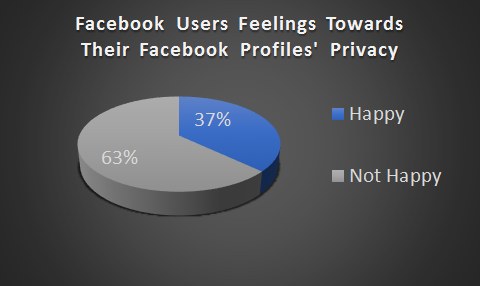
(Liu, Gummadi, Krishnamurthy, & Mislove, 2011) discussed how only 37% of people are happy with their Facebook privacy settings.
David told us this is only the beginning of payment revolution. It started with contactless payments on bank cards and has progressed with being able to pay by simply using an Apple device. My question is, where will it all stop? I think this progression is an extremely dangerous move for the security of our money. What do you think?
Want to hear more from David? Check out his LinkedIn or Twitter here!
Alistair Croll- Lean Analytics

Canadian Flag
You may be wondering where our final stop for the evening is. I am taking you to the land of poutine, maple syrup and Justin Bieber. Think you know where I’m taking you eh? Of course, with their continuous apologies and weird delicacies like milk in a plastic bag it couldn’t be anywhere else but Canada! Our final speaker for the night was the author of Lean Analytics, Alistair Croll.
Check out the video of Alistair speaking in The Helix here!
Mr. Croll had me interested in what he had to say from the very beginning as he undertook the hard task of making horses, tea, steam and perfume all relate to each other and to technology today. There have been many technological advances in different sectors. (Mulla, 2013) discussed how there have been advances to the agriculture sector. It is now one of the most booming sectors across the world. How has this happened? It is with the technological advances like farmers switching from using horse power to using machines like a combine harvester. It is with this advancement that we have seen exponential growth in the amount of food produced every year.
What is Lean Analytics- Alistair Croll
Back to the point at hand, like me you are wondering how these very different things (horses etc) can relate to technology today. We take so many things for granted today without even realising, myself included. Modern technologies are a normality that when we hear something like the Horse Manure Crisis of 1894 we almost scoff at how idiotic it sounds, but it was a real thing back then! Because of the continuous growth of transportation in 1894, there was also a growth in the amount of horse manure, so much so that one forecaster believed that the manure would reach third floor windows in Manhattan (Morris). Luckily Karl Benz invented the modern-day car and this problem solved itself.

Lean Analytics– Alistair Croll’s Book
Amongst other things we take for granted is certain products that are now available to us with ease like tea. Up until 1866 there used to be races between large ships to see who could bring back tea the fastest and people used to bet on these ships. Only thing is that as time went on captains had better knowledge of what the quickest routes were. Before you know it, the steam engine boat was created which decreased travelling time to a mere 78 days from Asia to the UK. It was with this technology that new products could be brought back to Europe from what seemed like far off lands.
Speaking of things that seem astonishingly ludicrous, there was the belief that the likes of perfumes could cure certain diseases. With the advancement of modern healthcare, it seems crazy to think that there was a time when people thought that by simply smelling something you would be cured of a disease. I’m sure even Dr. Walker was amazed by this. Nevertheless, perfume was utilised not solely for its it’s nice smell, but for its’ capability that can make an aeroplane fly, this to me is crazy!
I thoroughly enjoyed Alistair’s speech. It gave me great insight into the technological advances that have happened all around us in such a short number of years. It reminded me that we are only at the beginning of this evolution of technology and I for one am excited to see what comes next! What are your thoughts?
Loved Alistair and want more? Check out his LinkedIn or Twitter here!
Conclusion
As always, I will conclude with how I was feeling before coming to our last conference.
I was nervous, extremely so, because I had to present my project which I had been working on with my team for the whole year. This nervousness quickly disappeared when we got into the swing of things and started talking to other teams about our project. So, when the actual judges came over it wasn’t so daunting because all the questions they asked us had already been asked by our peers.
As for the conference itself, I was quite sad that it was all coming to an end. I have thoroughly enjoyed every one of them. I believe I have gained knowledge that I couldn’t have learned from any website, journal article or any other academic source out there. These conferences to me, were all about trying to educate us about what is happening in the real world today. It was with the help of these speakers that I gained insight about different things which I had no idea that were happening. I still dwell on things which I learned about in the previous conferences, like the epidemic of loneliness which Elva Carri spoke about in our first conference or how “crap content is crap” which Hugh Curran spoke to us about in our second conference. This information wasn’t just given to us as a point of interest, it was given to us so that we could do something about it, become better people because of it, mould our career around it.
Want to know more about this conference? Check out my friend Nicole Madden’s Blog here, or to get a different slant check out Sinead McCrohan’s blog here!
We need to realise that there are big changes happening in all sectors today. If there is one thing which I learned from these speakers is that to succeed today you need to be able to disrupt the market to come out on top.
Finally, I would like to thank all of those involved with these fantastic conferences along with the speakers. I would also like to thank all of you for reading my blog. I have had great viewership from all around the world including Ireland, the UK, the US, Canada, and one view all the way from Lebanon! As of the 30th of April, I have had 91 views altogether, and I would like to thank each and every one of you for having the patience for reading through my blog posts! What do you think will be the biggest change to happen in the next couple of years? Let me know in the comments below. Don’t forget to check out my top 10 extra articles and videos list below! That’s it we have travelled the world and heard from some great speakers. In the meantime, my advice to you, the reader, is don’t be scared, go out there and disrupt the world and don’t be afraid to do it! Why not check out my top 10 extra video and articles below!
As always if you want to hear more from me you can follow me on Facebook, Twitter, or check out my GoodReads account!

That’s All Folks Gif
My Top 10 Extra Videos and Articles List:
1.) Addressing Cloud Computing Security Issues
2.) Advances In Wearable Technology And Applications In Physical Medicine And Rehabilitation
3.) Connectivism: A Learning Theory For The Digital Age
4.) A View Of Cloud Computing
5.) Cloud Computing And Emerging IT Platforms: Vision, Hype, And Reality For Delivering Computing As The 5th Utility
6.)
Technology Is Reinventing Humanity, Jordan Nguyen, TEDxSydney
7.)
What Happens When Our Computers Get Smarter Than We Are? Nick Bostrom
8.)
Thinking Forward About Cloud Computing, John Easton, TEDxLancasterU
9.)
Changes To Computer Thinking – Stephen Fry Explains Cloud Computing
10.)
Logonaire A Brief Explanation
References- Academic Sources
Boulton, C. (2016, May 10). Why banks are finally cashing in on the public cloud. Retrieved April 27, 2017, from CIO: http://www.cio.com/article/3068517/cloud-computing/why-banks-are-finally-cashing-in-on-the-public-cloud.html
Doukas, C., Pliakas, T., & Maglogiannis, I. (2010). Mobile healthcare information management utilizing Cloud Computing and Android OS. Engineering in Medicine and Biology Society (EMBC), 2010 Annual International Conference of the IEEE, 1037-1040. Retrieved April 26, 2017
Easterlin, R. A. (1995, June 30). Will raising the incomes of all increase the happiness of all? Journal of Economic Behavior & Organization, 27(1), 35-47. Retrieved April 27, 2017
European Commission. (2017). Payment services (PSD 2) – Directive (EU) 2015/2366. Retrieved April 27, 2017, from Europa: https://ec.europa.eu/info/law/payment-services-psd-2-directive-eu-2015-2366_en
Jukes, I., McCain, T., & Crockett, L. (2010). Understanding the digital generation: Teaching and learning in the new digital landscape. Corwin Press. Retrieved April 27, 2017
Lenz, R., & Kuhn, K. A. (2004). Towards a continuous evolution and adaptation of information systems in healthcare. International journal of medical informatics, 73(1), 75-89. Retrieved April 16, 2017
Liu, Y., Gummadi, K. P., Krishnamurthy, B., & Mislove, A. (2011). Analyzing facebook privacy settings: user expectations vs. reality. Proceedings of the 2011 ACM SIGCOMM conference on Internet measurement conference, 61-70. Retrieved April 20, 2017
Lyons, R. (2017). Introduction to Social Media Marketing. Dublin: Roisin Lyons.
Mell, P., & Grance, T. (2011). The NIST definition of cloud computing. Retrieved April 28, 2017
Met Éireann. (n.d.). Rainfall. Retrieved March 14, 2017, from Met Éireann: http://www.met.ie/climate/rainfall.asp
Moodie, P. M. (1973). Aboriginal health. Aboriginal health. Retrieved April 19, 2017
Morris, E. (n.d.). From horse power to horsepower. Access Magazine, 1(30), 2007. Retrieved April 27, 2017
Mulla, D. J. (2013). Twenty five years of remote sensing in precision agriculture: Key advances and remaining knowledge gaps. Biosystems engineering, 114(4), 358-371. Retrieved April 27, 2017
Olsson, P., Folke, C., & Hahn, T. (2004). Social-ecological transformation for ecosystem management: the development of adaptive co-management of a wetland landscape in southern Sweden. Ecology and Society, 9(4). Retrieved April 27, 2017
Prichard, J. J., MacDonald, L. E., & Hunt, L. (2004). Cyber terrorism: A study of the extent of coverage in computer security textbooks. Journal of Information Technology Education, 3. Retrieved April 27, 2017
Rosenthal, J. A., & Ocampo, J. M. (1988). Securitization of credit: inside the new technology of finance. John Wiley & Sons. Retrieved April 27, 2017
Russell-Smith, J., Yates, C. P., Whitehead, P. J., Smith, R., Craig, R., Allan, G. E., . . . Gill, M. A. (2007). Bushfires ‘down under’: patterns and implications of contemporary Australian landscape burning. International Journal of Wildland Fire, 16(4), 361-377. Retrieved April 27, 2017
Yan, Q., & Vaseghi, S. (2003). Analysis, modelling and synthesis of formants of British, American and Australian accents. Acoustics, Speech, and Signal Processing, 2003. Proceedings.(ICASSP’03), 1. Retrieved April 27, 2017
Pictures Sourced
22Seven Company Picture. Retrieved from http://now.vodacom.co.za/images/8012/880/518/image.jpg
22Seven Logo. Retrieved from https://www.22seven.com/
Alistair Croll Headshot. Retrieved from http://cloud.maxlefrancois.com/wp-content/uploads/2015/06/AlistairCroll.jpg
Australian Flag. Retrieved from http://countrydigest.org/wp-content/uploads/2016/03/Australia-Flag-Map.png
Canadian Flag. Retrieved from http://i.huffpost.com/gen/3570684/images/n-CANADA-MAP-large570.jpg
David Erixon Headshot. Retrieved from https://www.linkedin.com/start/view-full-profile?_ed=0_GPbWFr5qpRQ2ev5D1t_ElfsGj4mx7Qh86Yp5xk32OVn2BLIg6ZiCk2e7ukf9J7H2&trk=public_profile_tc-view
Dr. Johnny Walker Headshot. Retrieved from http://www.google.com/url?q=http%3A%2F%2Flinkedin.com%2Fpub%2FJohnny-walker%2F10%2F809%2F905&sa=D&sntz=1&usg=AFQjCNHWBDupJAWYgCnLYA-KGWc3WkpJoQ
Get Digital Cover Photo Retrieved from https://loop.dcu.ie/mod/resource/view.php?id=676277
Jinga Life Family Tree. Retrieved from https://static.wixstatic.com/media/3688bb_e2055d50cb4a4b4e8ef642527539f628~mv2.png/v1/fill/w_613,h_615,al_c,usm_0.66_1.00_0.01/3688bb_e2055d50cb4a4b4e8ef642527539f628~mv2.png
Jinga Life Logo. Retrieved from https://pbs.twimg.com/profile_images/378800000630132771/284a1774cc74aa256e2de8c8052b5e86.jpeg
Jinga Life Logo 2. Retrieved from https://diceprojectbirthesieverding.files.wordpress.com/2013/11/jinga-life.jJinga Life Logo 2. (n.d.). Retrieved from https://diceprojectbirthesieverding.files.wordpress.com/2013/11/jinga-life.jpg
Lean Analytics- Alistair Croll Picture. Retrieved from http://countrydigest.org/wp-content/uploads/2016/03/Australia-Flag-Map.png
Sunshine Gif. Retrieved from https://media.giphy.com/media/10d3NDzD40xb0s/giphy.gif
Swedish Flag. Retrieved from http://www.europeanwaterfalls.com/wp-content/uploads/Sweden_flag.png
Ulster Bank Logo Retrieved from https://media.balls.ie/uploads/2014/02/New-logo-white-bkground1.jpg
Advertisements Share this:





